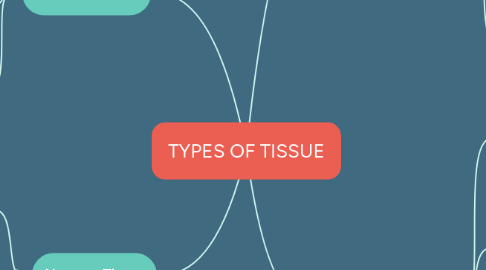
1. Muscular Tissue
1.1. Skeletal Muscle
1.1.1. Arise during development when several cells fuse,resulting in one fiber with multiple nuclei
1.1.2. Cylindrical and quite long
1.2. Smooth(visceral) Muscle
1.2.1. Contract more slowly than skeletal muscle , but can remain contracted for a longer time
1.2.2. Found in the walls of viscera and blood vessels
1.3. Cardiac Muscle
1.3.1. Found in the walls of the heart
1.3.2. Separate and individual,but bound end to end at intercalated disks
2. Nervous Tissue
2.1. Neurons
2.1.1. Dendrites
2.1.2. A cell body
2.1.3. Axon
2.2. Neuroglia
2.2.1. Support and nourish neurons
2.2.2. Contribute to brain function
2.2.2.1. Microglia
2.2.2.2. Astrocytes
2.2.2.3. Oligodendrocytes
2.2.3. Found in the brain
3. Epithelial Tissue
3.1. Types of epithelial tissues in vertebrates: 1)Simple squamous 2)Simple cuboidal 3)Simple columnar 4)Pseudostratified,ciliated columnar 5)Stratified squamous
3.2. Covers surfaces and lines body cavities
3.3. Has a protective function
3.4. Carry out secretion,absorption,excretion,and filtration
3.5. Simple Epithelia
3.5.1. Squamous Ephitelium
3.5.2. Cuboidal Ephitelium
3.5.3. Columnar Ephitelium
3.6. Stratified Epithelia
3.7. Glandular Epithelia
3.7.1. Ex: Sweat gland of skin and Pancreatic exocrine gland
4. Connective Tissue
4.1. Fibrous Connective Tissue
4.1.1. Loose Fibrous Connective Tissue
4.1.2. Adipose Tissue
4.2. Supportive Connective Tissue
4.2.1. Cartilage
4.2.1.1. Hyaline Cartilage
4.2.1.2. Elastic Cartilage
4.2.1.3. Fibrocartilage
4.2.2. Bone
4.2.2.1. Compact Bone
4.2.2.2. Spongy Bone
4.3. Have 3 components: 1)Specialized cells 2)Ground substance 3)Protein Fibers
4.4. Fluid Connective Tissue
4.4.1. Blood
4.4.1.1. Red Blood Cells
4.4.1.2. White Blood Cells
4.4.1.3. Platelets
4.4.1.4. Lymph
